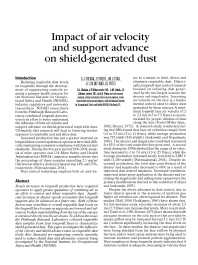Mining Publication: Impact of Air Velocity and Support Advance on Shield-Generated Dust
Original creation date: April 2010
Steady increases in longwall production have required operators to apply greater quantities of ventilating air in an effort to control and dilute respirable dust. Significant increases in shearer speeds necessitate that longwall supports also be advanced at a faster rate. Both of these factors may contribute to overall respirable dust levels on the longwall face because as supports are lowered and advanced, broken material falling from the top of the canopy is entrained directly into the air stream. To address this issue, the Pittsburgh Research Laboratory collected respirable dust samples from four longwall faces to characterize shield-generated dust. This paper investigates the influence of air velocity and shield advance rates on respirable dust levels. Also discussed are engineering controls currently used to reduce shield dust and alternative controls being investigated by the National Institute for Occupational Safety and Health (NIOSH).
Authors: GJ Chekan, JP Rider, JM Listak, JF Colinet, JD Potts
See Also
- Best Practices for Controlling Respirable Dust in Coal Mines
- Control of Respirable Dust
- Dust Underfoot: Enclosed Cab Floor Heaters Can Significantly Increase Operator's Respirable Dust Exposure
- The Effects of Water Spray Placement for Controlling Respirable Dust and Face Methane Concentrations
- Evaluation of the Approach to Respirable Quartz Exposure Control in U.S. Coal Mines
- Improved Drill Shroud Capture of Respirable Dust Utilizing Air Nozzles Underneath the Drill Deck
- Improving Silica Dust Control Through Targeted Research
- Laboratory Evaluation of Shield Dust Entrainment in High-Velocity Airstreams
- Laboratory Testing To Quantify Dust Entrainment During Shield Advance
- Performance of a Light Scattering Dust Monitor at Various Air Velocities: Results of Sampling in the Active Versus the Passive Mode
- Content source: National Institute for Occupational Safety and Health, Mining Program


 ShareCompartir
ShareCompartir
